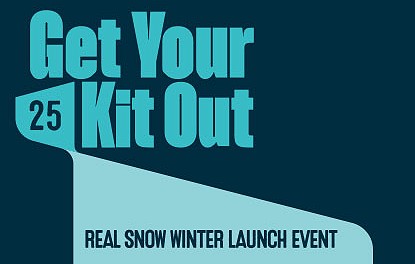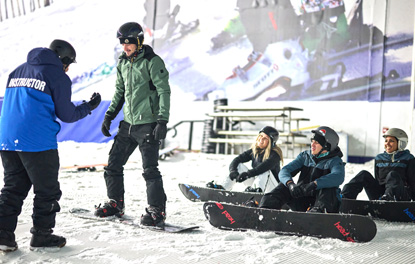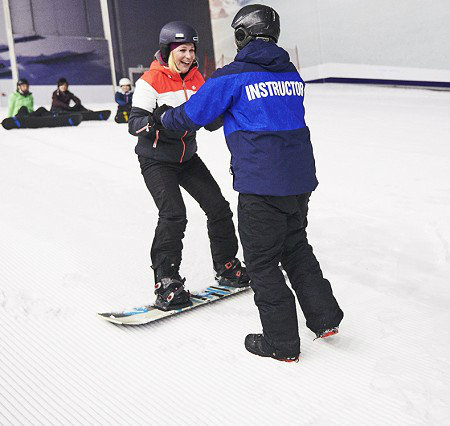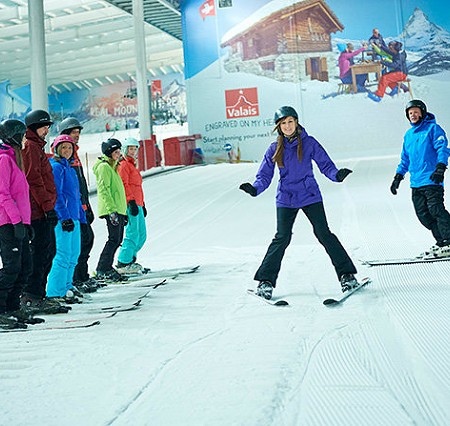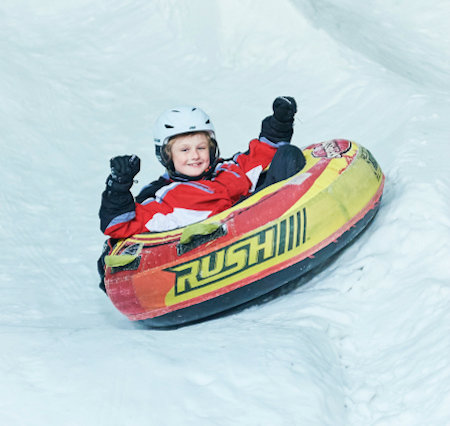How to Learn Snowboard Tricks
30 May 2017
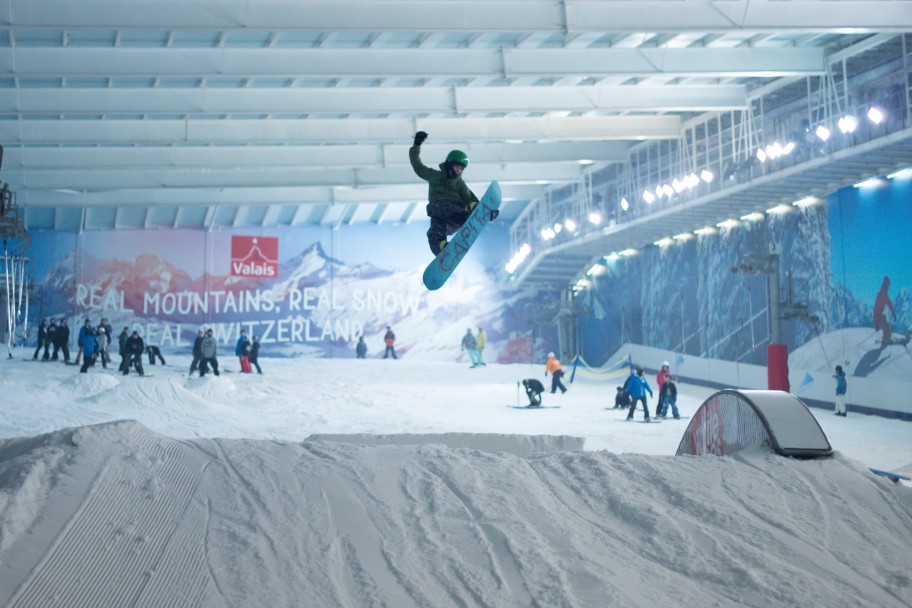
Naturally, as a progressing snowboarder, there’ll come a time when you feel compelled to leave the ground and challenge yourself beyond simply travelling down the slope. When thoughts of how to bend the rules and catch some air drift-to-mind, its time to start learning some snowboard tricks.
How Can you Learn Snowboard Tricks?
There’s plenty of ways to learn and prepare for landing snowboarding tricks, one of which is taking some of our snow boarding lessons for adults, so here’s a guide to get you well on your way to popping some new moves on your board.
1. Make sure you have the basics on lock
To land most snowboarding tricks, even the easy ones you’re going to need to have great board control, the skill to ride away, and the ability to either set yourself up to ride in, or ride out switch.
When we talk about ‘Switch’ snowboarding, we’re referring to the position you’re snowboarding in. In simple terms, it means snowboarding with your ‘unnatural’ or perhaps ‘non-dominate’ leg leading. So, if you’re a regular snowboarder, who normally snowboards with your left leg leading, to ride switch, you’ll need to lead with your right leg. If you’re a goofy rider, most comfortable snowboarding with your right leg leading, you’ll need to learn to lead with your left leg in order to ride switch.
To start landing effective snowboard tricks, it's important to be comfortable snowboarding with either leg leading. If you’re not quite at ease with switch riding, practice snowboarding varied terrain, and turning and skating along on your snowboard with your other leg leading.
When we say it’s necessary to have the basics on lock, alongside riding switch that includes, being able to stop in control, make various turn shapes on your snowboard, and possess the ability to apply a range of snowboard techniques to varied terrains and conditions. Stepping just outside your comfort zone to enable yourself to learn new snowboard tricks will allow you to progress, but pushing to hard, without building the foundations could actually set your confidence back, construct bad technique or cause injury. Think about pushing yourself a little bit at a time and gradually expanding your skill set. If you’re unsure as to whether you’re ready take things to the next level, a qualified snowboard coach should be able to give you the guidance you need.
2. Start with flatland snowboard tricks
Once you have the snowboarding necessities, landing tricks on freestyle features, such as rails or jumps is not the next step. Learning flatland or jib tricks on the snow will help you ensure you have the fundamentals of freestyle and the mechanics of basic tricks. Practising flatland snowboard tricks on the snow will also build your confidence and help you develop some of the skills you’ll need to handle a jump or box more effectively.
During flatland snowboard sessions it’s beneficial to be introduced to the following freestyle techniques and tricks, you can learn more about these in Flatland Freestyle Coaching Sessions, and by watching online hints and tips videos.
Pop
Pop is one way of getting air on your snowboard. In fact, popping should be your go-to method anytime you hit a jump — so its essential to master a controlled pop before progressing to boarding features or attempting other tricks on the snow.
You can practice popping on the flat while stationary, by sinking down through your knees and pushing off the ground with both feet. Evenly pushing through either, both heals, or both toes, allows for a nice clean pop with a stable take-off into the air. This progresses nicely to popping off your toes, and then off your heals while traversing across the slope. With the pop being the ‘go-to’ technique for hitting jumps, mastering pop on the snow is the first step in progressing to riding jumps.
Ollies
Ollie’s are another way of getting off the ground, but they’re usually used when you’re racing along a gentle even terrain, travelling on the base of your board, rather than when you’re traversing on an edge. So if you’re snowboarding a track at speed, you could use an ollie to get a little air to jump over a small rock. Alternatively, you could ollie off a roller or off a bump.
You can try an Ollie when stationary or whilst moving. Whether you’re static or riding along, begin with your weight evenly spread out over the board. Sink down, bending into both your knees, and shift your weight into your back leg, pushing back into the flexible tail of your board. Then, immediately spring upwards off your back foot, and at the same time lift up your front leg so that the nose of your board lifts off the ground first. As you get some air, lift your back leg up to level the board out, so that you can land with a flat base. Make sure you keep the board pointing straight in the direction you’re travelling and land gently, bending your knees as do.
Nollies
The Nollie is an almost identical trick to the Ollie. Similarly, it allows you to get air and take-off from a flat base when stationary or whilst moving. Differently, instead of popping off the tail of the board, to complete a Nollie you apply the same process, but by popping off the nose of the board instead.
Butters
Flatland Butters are an important trick to learn, because they introduce you to the feel of spinning around on the board’s nose or tail. It’s an on-snow trick that can later be progressed to jumps and rails, and it’s a great drill for improving board control.
To try a Flatland Butter, start on a gentle slope on either your heal or toe edge. Then allow your board to traverse a little across the hill, before applying weight to one end of the board and lifting the other end off the ground. As you do so, rotate your arms and head down or up the hill and maintain a pressed position. With enough momentum and rotation and by holding a strong press position with one leg lifted, you should begin to spin on one end of the board (either the nose or tail). Maintain a strong press position throughout the rotation and adjust the pressure in your toe and heal edge to ensure you don’t catch an edge as the pressed end of the board slides over the snow. Continue the rotating your arms and head until you’ve spun 360 degrees, then repeat spinning the other way and then with the other foot pressed.
180 & 360 degree spins
If you can’t 180 degree spin on the flat or while traversing across the slope, you’ve got next to no chance of riding away from a 180 attempt on a jump. Watch our videos on 'How to 180' and 'How to 360.'
Learn these flatland snowboard tricks with Freestyle Coaching Sessions at The Snow Centre or watch SnowSure’s hints & tips videos.
3. Watch snowboard trick tutorials online
Whether you’ve picked up some freestyle coaching sessions or not, online tutorials are still really helpful when processing the visual ‘how to’ around a snowboard trick. Watch our snow tips videos to help you progress your skills.
4. Get some Freestyle Coaching
A qualified freestyle coach will be able to teach you how to best land a flatland trick on you snowboard, and how to progress to riding feature’s such as boxes, rails and jumps.
5. Practice flatland drills
Even once you’ve mastered a flatland trick or taken a few tricks to a jump or rail, practicing freestyle drills over and over again continues to improve your strength, agility and timing. Flatland drills also make for great warm-ups in preparation for landing bigger tricks on freestyle features. Ask your Freestyle Coach for some flatland drills to get you pumped for the park.
6. Film yourself & watch it back
If a trick isn’t working for you, or even if it is, it’s beneficial to film yourself or ask someone to film you and watch it back. You’ll be surprised at the things you spot when watching yourself in action; the height you thought you had, but didn’t, the tweaks that can be made to make that trick look and feel even better and so on.
7. Practice regularly in the freestyle park
Snowboard freestyle tricks take time to master, and without regular practice, confidence can drop and it can become easy to find yourself taking two steps backwards to take one step forward. Luckily most indoor centre’s and dry slope run freestyle sessions every week, so you don’t have to wait until your trip to the mountains to get your park skills back in tact.
At The Snow Centre, park nights take place on Thursdays 6pm-10pm and Friday’s 6.30pm-10.30pm.
